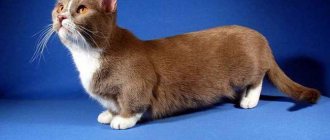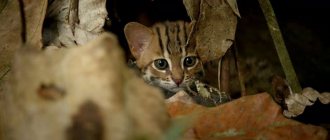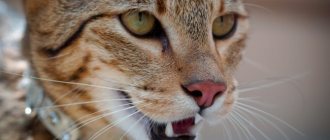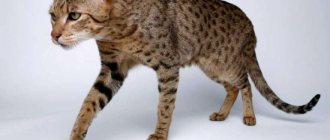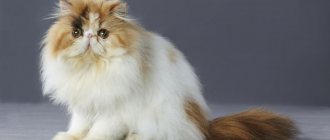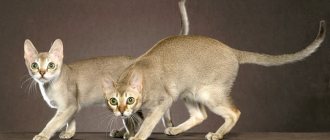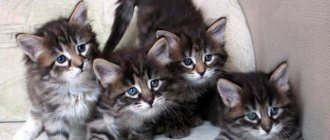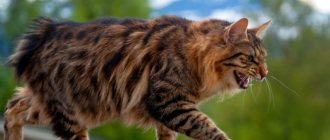Felines are a family of mammals belonging to the order Carnivora. Most often, they get their food by sneaking up and stalking it, sometimes by chasing it.
This family includes many animals, some of which, such as the Amur tiger, are impressive in size and weight. But there are also miniature animals whose weight does not exceed 1 kg.
The smallest wild cats in the world can live in different parts of the planet. But, unlike big cats, they give birth every year or more often, they can give birth to 5 to 6 cubs. This is the only thing that unites them, and their appearance, color, habits and lifestyle can differ significantly.
Each of them has its own unique character, although most eat rodents, are nocturnal and prefer solitude.
Jaguarundi
They are part of the Puma genus. They have an elongated body, particularly flexible, short but strong legs and a long, thin tail. In appearance, it is somewhat similar to a weasel. It is bright red or brown mixed with other shades.
The length of the jaguarundi is from 55 to 77 cm, plus a tail, which can grow up to 33-60 cm, height - from 25 to 35 cm. You can meet it in America. They live alone. They are terrestrial animals, especially active during the day, but they can climb trees.
They feed on small prey (up to 1 kg), everything they can catch. Sometimes they raid poultry houses, or eat green figs.
Dwarf minskin
This phenomenon was produced by crossing two varieties of cats, such as the Canadian Sphynx and the Munchkin. The breeding took place in the United States of America.
If we consider the descriptive characteristics of this cat, they boil down to the fact that the animal is not covered with hair at all, has a long body within twenty centimeters, and its weight does not exceed two kilograms, seven hundred grams.
forest cat
This small predator lives in Europe, as well as in Africa and Asia, which is also called the wild or European cat . He regularly hunts small animals and birds. Lives alone.
The forest cat is timid and tries to avoid people, often being aggressive. These animals have brown fur with black stripes. They have a thick tail. Body size is forty-five to eighty centimeters, height is thirty-five centimeters, while the length of the tail is thirty centimeters. They weigh from three to eight kilograms. African subspecies are much smaller in size.
Advantages and disadvantages
Despite the fact that yard cats do not have such exclusive characteristics as their purebred counterparts, they are nevertheless not without merit.
- Lasting immunity
. Breeding breeds using selective breeding methods has greatly weakened the immune system of animals. This is why the life expectancy of street cats is many times higher than that of purebred pets. Yard cats have strong protective functions of the body and are able to resist many infections. - Temper
. Such animals tend to be docile in nature. They become very attached to the owner who picked them up on the street. - Reproduction.
Since yard cats do not need a purebred partner, finding a mate for them to reproduce will not be difficult. - Indispensable in the household
. Outdoor cats are excellent mouse hunters. Nature endowed the animal with these qualities, and it is among the domestic representatives of the family that this instinct is much more developed. - Price
. You don't need a big investment to get a pet. You can pick up a cute, albeit not purebred, kitten on the street. Some cats even choose their own owner, coming to visit and “imposing” themselves. - Exhibitions for yard cats
. You heard right. Indeed, there are special exhibitions designed for outbred cats. On them, judges evaluate the external characteristics of the animal and its grooming.
The disadvantages include the inability to make decent money on the offspring of a pet and the excessive sensitivity of non-pedigreed cats. These animals are very sensitive to any changes that occur in their usual habitat. Noisy feasts and even rearrangements in the house can negatively affect the pet.
Today, many pet owners prefer to have yard cats due to their omnivorous nature, ease of care, and strong immunity. It is not entirely correct to call such cats outbred, since all breeds from ancient times originated from wild animals and were subsequently modified depending on their habitat and lifestyle.
Iriomotean cat
This is a subspecies of the Bengal cat that lived on the small island of Iriomote, located near Taiwan. For a long time, the Iriomotean cat was considered a separate species. It was discovered in 1965.
The length of a cat with a tail is from seventy to ninety cm, and it makes up about 25% of its length. It weighs from three to five kg. It is dark brown in color, with small dark spots, which then merge into stripes. The animal prefers a nocturnal lifestyle, and during the day it hides in secluded corners. Prefers a solitary life. It feeds on rodents, waterfowl and crabs.
Now the number of these animals is rapidly declining, because... The meat of the Iriomotey cat is considered a delicacy among the local population. There are now less than 100 individuals.
Oncilla (lat. Leopardus tigrinus)
One of the most poorly studied cats lives in the mountainous and misty evergreen forests of Central and South America. The name of this predator is translated as “miniature jaguar,” which is quite justified - in all its appearance, oncilla resemble a reduced-sized jaguar.
Oncilla. Photo: Anne-Marie Kalus
Oncillas are only slightly larger than their domestic relatives: an average weight of about 3 kg, body length 65 cm, tail - 30-40 cm. The main difference between the oncilla and other representatives of the genus of tiger cats (Leopardus) is its disproportionately large eyes and ears.
Beautiful soft ocher-colored fur with dark spots played a cruel joke on the animals. In the 1970s and 80s, tens of thousands of oncillas were exterminated as a result of poaching; in 1983 alone, border guards seized 84,000 skins. According to some estimates, over these 20-odd years, 95% of the small jaguar population was destroyed.
Today, any hunting of oncillas is prohibited, as is the sale of any products made from their skin, but the population is nevertheless in no hurry to recover; on the contrary, due to massive deforestation, it is only declining.
Small jaguar in the wild. Photo: Carlos Alfaro
A small jaguar can also be domesticated relatively easily, but in a “gust of passion” the wild nature of the animal can still take its toll - you need to play with the oncilla very carefully
Manul
Otocolobus manul comes from Greek words that can be translated as “dwarf ear.” cat is also called Pallas's cat , after the man who first described it in 1776. It was a naturalist from Germany P.S. Pallas.
In size, it resembles an ordinary cat: length - from 52 to 65 cm, and tail - from 23 to 31 cm. Pallas's cat weighs two to five kg. He has a thick and long tail, sideburns on his cheeks, and small and round ears.
Among the cats, the Pallas's cat is the fluffiest. The fur is gray, the fibers have white tips, which makes it seem like it is dusted with snow. There are narrow stripes. It can be seen in Asia, in steppe or semi-desert areas of the mountains.
It is active at night or early in the morning; during the day it sleeps in a shelter: in rocks or in old burrows. Eats rodents and pikas, sometimes larger prey. Pallas cats do not know how to run fast; they hide from enemies by climbing rocks and stones. Their numbers are rapidly declining.
Dwelf
Next in the ranking is such a representative of the cat as Dwelf. As for the main components of this variety, the story is the same as with the Minskin, since the main participants in this process are the Canadian sphinxes and munchkins. As for the main difference, it was achieved thanks to the intervention of such a third breed as the Curl of American origin.
If we consider the basic description of Dwelfs, we can highlight the following distinctive characteristics:
- complete absence of fur;
- the ears are very large and have the shape of elf ears;
- short stature of the breed;
- the eyes have a large round shape with a characteristic bulging;
- a tail similar to that of a rat;
- The weight of representatives of this breed does not exceed three kilograms.
“This feline is very funny and has the appearance of an interesting animal, completely different from a typical cat.”
Long-tailed cat
a long-tailed cat
lives in dense forests , which is also called margay . The length of its body is from sixty to eighty cm, plus a long tail (40 cm). It weighs from four to eight kg. She has a yellowish-brown coat that has dark ring-shaped spots on it.
Prefers solitude and emerges from its hiding place only at night. Eats rodents, birds, and small primates. This cat spends most of its life on branches. Long-tailed cats are now endangered. It is prohibited to catch or shoot them.
Kalimantan cat
Its other name is Borneo cat . She lives on the island of Kalimantan, which belongs to Malaysia and Indonesia. This is a rather rare and poorly studied species. The first whole animal was discovered in 1992, she fell into a trap. She was transported half-dead to the Sarawak State Museum.
It was only in 2002 that they were able to of a Kalimantan cat in the wild Her body length is 58 cm, she weighs from 2.3 to 4.5 kg.
American Curl
The American Curl comes in a wide range of sizes due to its diverse gene pool, however most tend to be quite petite. Their most famous feature is the curled ears towards the base of the skull, which give the breed its name. The unusual bend gives the ears the appearance of ears turned inside out. For show cats, ears are the most stringent criterion. Representatives of the breed whose ears are curled too far (more than 180 degrees) or insufficiently (less than 90 degrees) will be disqualified.
The American Curl was first bred in 1981 in Lakewood, California. A black long-haired cat named Shulamith became the progenitor of a new breed, from which every American Curl today can trace their ancestry. The curvature of her ears was a spontaneous, natural mutation that manifested itself as a dominant gene. More in-depth laboratory testing showed that the mutation did not lead to additional defects or health problems. Shulamith's offspring were absolutely healthy and stable cats.
At birth, their ears are erect; they begin to curl after 2-10 days. The ears curl and unfold to varying degrees over the next four months. When the ears take their final shape, the lower two-thirds of the ear is hard cartilage rather than soft flesh like most cat breeds. The upper third remains soft and pliable. You need to be careful with the ears of the American Curl so as not to damage the hard cartilage. But in other respects they are a fairly unpretentious breed.
The American Curl has a wedge-shaped muzzle, an elongated body and round eyes. The height of cats varies from 22 to 30 cm. The curly coat is long or short. They are friendly, captivating and incredibly cute pets. The American Curl, which remains energetic into adulthood, has been nicknamed “the cat’s Peter Pan.” Cats reach maturity at 2-3 years, so they retain the energy of a kitten into adulthood.
This is not a very vocal cat breed and in most cases they express affection through physical contact. The American Curl is an extremely adaptable cat, getting along well with other cats and quickly adapting to new family members. If necessary, they will do well alone for long periods of time.
Velvet cat
The velvet cat is one of the smallest: its body length is from 65 to 90 cm, but slightly less than half of this length (40%) is its tail. Its height is twenty-four to thirty cm, and it weighs from 2.1 to 3.4 kg; females are even smaller.
The velvet cat has thick fur, which can protect it from sub-zero temperatures. The color ranges from sand to gray, with brownish stripes on the back. Found in hot, dry areas: sandy deserts, rocky valleys.
They are especially active at night, and during the day they hide in abandoned burrows of other inhabitants of the area. They eat game, anyone they can catch. They may not drink for a long time.
Sumatran cat
The Sumatran cat Sumatra
, Borneo, etc. It is reddish-brown in color, with thick and soft fur, its chest and abdomen are white, there are brown spots on the sides, and 2 white stripes on the forehead.
This is a miniature animal, its length is from 53 to 81 cm, and its weight is from 1.8 to 2.7 kg. It feeds on frogs, fish, etc., living in the water. Sometimes poultry is stolen. They love fruits and dig up edible roots in the ground.
Southern tiger cat
In 2013, the Southern tiger cat or Southern tigrina was recognized as a separate species. Lives in Brazil, Paraguay, Argentina, etc. Their body length is from 36.5 to 49 in females and from 44 to 55.5 cm, and their tail length is from 213 to 35 cm.
Males weigh from 1.91 kg to 2.42 kg, and females - from 1.3 to 2.21 kg. The Southern Tiger cat has a yellowish-brown coat that becomes lighter on the sides, and a white or light belly. It feeds on mice, birds, shrews, lizards, and sometimes hunts larger prey. Endangered.
Spotted ginger cat
She belongs to the genus of Asian cats. It can be found in India and Sri Lanka. The rusty cat is endangered; there are only about 10 thousand adult individuals in the world. Its length is from thirty-five to forty-eight cm, and its tail is from fifteen to thirty cm. An adult cat of this breed weighs 0.9 -1.6 kg.
Externally, the Spotted Red cat resembles a Bengal; its coat is gray, but it has “rusty” spots. The belly is light. They lead a solitary lifestyle and go hunting at night. They feed on mice, lizards and various insects. They spend a lot of time on the ground, although they can climb trees.
These cats give birth to one to three cubs, but most often one baby is born. The number of these animals is constantly decreasing, because... their habitat changes.
5 2
Kinkaloe
The representative of that breed is the second largest in the whole world. This baby originally appeared as a result of crossing two breeds such as the Curl, a cat of American origin, and the Munchkin. As for wide distribution, today these representatives of babies are very difficult to find, since they are not very common and their number totals several dozen around the world. The weight of an adult cat reaches only one and a half kilograms.
Most of these cats are dealt with by one of the Moscow nurseries, where you can purchase them.
